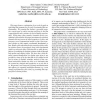95 search results - page 13 / 19 » Determination of Motion Breakpoints in a Task Sequence from ... |
TOG
2008
13 years 7 months ago
2008
Modeling the large space of possible human motions requires scalable techniques. Generalizing from example motions or example controllers is one way to provide the required scalab...
CHI
2009
ACM
14 years 8 months ago
2009
ACM
While learning new motor skills, we often rely on feedback from a trainer. Auditive feedback and demonstrations are used most frequently, but in many domains they are inappropriat...
IJIG
2002
13 years 7 months ago
2002
This paper forms a continuation of our work focused on exploiting film grammar for the task of automated film understanding. We examine film rhythm, a powerful narrative concept u...
ECCV
2006
Springer
14 years 9 months ago
2006
Springer
In this paper we address the problem of aligning 3-D data with articulated shapes. This problem resides at the core of many motion tracking methods with applications in human motio...
IROS
2006
IEEE
14 years 1 months ago
2006
IEEE
— Autonomous service robots have to recognize and interpret their environment to be able to interact with it. This paper will focus on service tasks such as serving a glass of wa...

